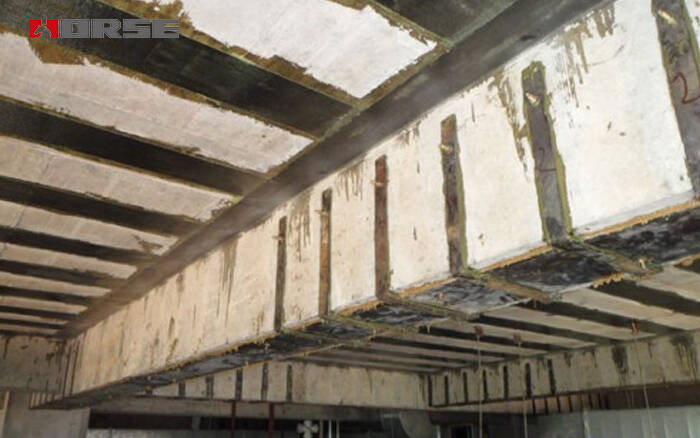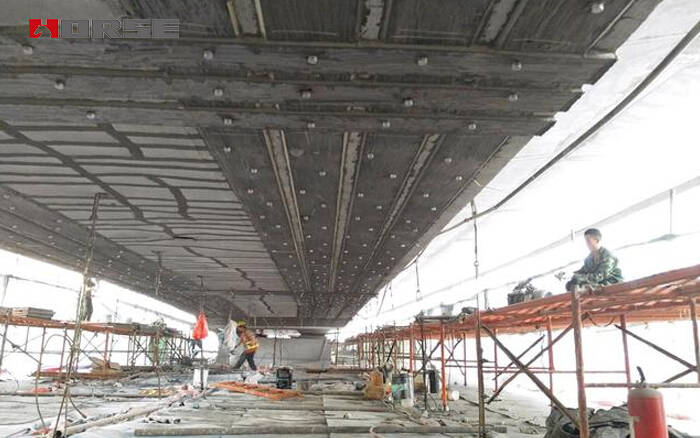Beam strengthening
Strengthened with bonded steel plates
As an important technical means of bridge reinforcement, adhesively steel plate method has the characteristics of high strength, high efficiency, convenient operation and economy. It can be applied to various bridge structures and different structural parts. It has been gradually applied in bridge reinforcement projects in recent years.

For a long time, the bridge in operation will be aging gradually with the passage of time, and the bearing capacity will be reduced. In order to improve the bearing capacity of the bridge and prolong the service life of the bridge, it is necessary to reinforce the bridge. As an important technical means of bridge reinforcement, adhesively steel plate method has the characteristics of high strength, high efficiency, convenient operation and economy. It can be applied to various bridge structures and different structural parts. It has been gradually applied in bridge reinforcement projects in recent years.
At present, scholars at home and abroad focus on "one-time stress" in the research of reinforced concrete beams strengthened by sticking steel plates, that is, in the actual reinforcement project, in the compression zone of flexural members strengthened by sticking steel plates. Generally, the calculation is carried out according to one-time stress of double-bared beams, and the experimental study focuses on the influence of the position and width-thickness ratio of the steel plates on the bearing capacity of the strengthened beams. In contrast, there is little research on the reinforcement of reinforced concrete beams by sticking steel plates under secondary loads, only the analysis of the mechanical characteristics and the calculation of the normal section bearing capacity of the steel plate-reinforced concrete members are simply carried out.
The current "Highway Bridge Reinforcement Design Code" stipulates: "Before pasting steel plates, the strengthened members should be unloaded". Therefore, the concrete stress and steel plate stress should be taken into account in the calculation formula of bearing capacity, and the increase of the design bearing capacity of the strengthened beam should be limited. The maximum amount and deformation of bondable steel plates under unloading are checked, instead of simply applying the design calculation formula of the bearing capacity of reinforced concrete structures. Because the design does not consider the actual situation, it not only wastes steel, but also causes ductility deterioration, brittleness enhancement, deformation increase and seismic performance of members after strengthening, so it should be paid enough attention to. Therefore, on the basis of summing up the existing achievements and combining with the engineering examples, this paper deduces the calculation formula of the true bending capacity of the beams strengthened by sticking steel plates.

1) Considering the influence of secondary force, the theoretical formula of ultimate bearing capacity of reinforced concrete beams strengthened with steel plates is deduced by applying elastic mechanics theory, which is different from the formula without considering the influence of secondary force.
2) After the reinforced concrete beams are strengthened with steel plates, the secondary stress has an effect on the height of the limit compression zone under the condition of suitable reinforcement failure, and the influence is related to the first stress of the original member. According to the formula for calculating the maximum amount of bonded steel plates required in the tension zone, the brittle failure of reinforced beams can be avoided and the waste of reinforced steel plates can be reduced, which provides a reference for the calculation and analysis of reinforced concrete flexural members.
3) The bearing capacity calculation formula of reinforced concrete structures strengthened with steel plates in the current Code for Design of Highway Bridges should consider the magnitude of bearing capacity increase, the maximum amount of steel plates to be bonded, the actual stress-strain relationship of the structure in the process of strengthening, and the influence of secondary force on the strengthening effect.